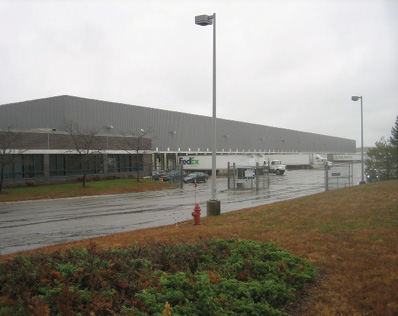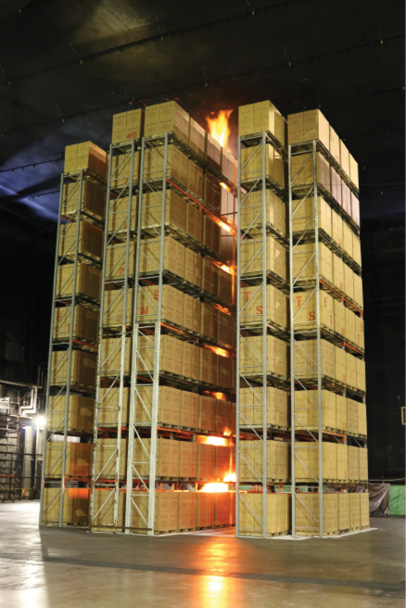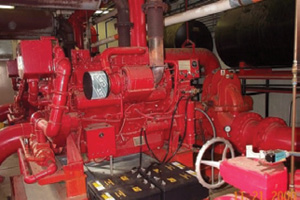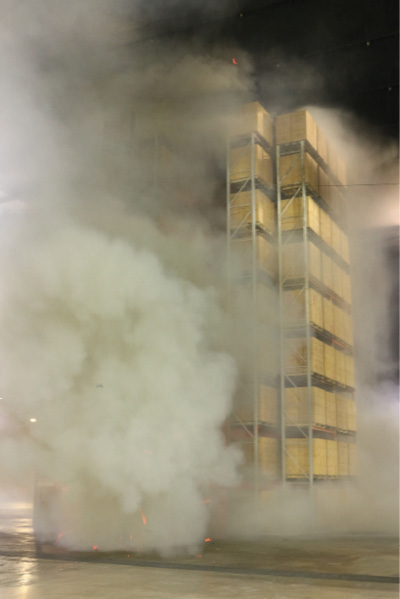
BY JAMES BURNHAM
Following the development of the forklift truck and the pallet during World War II, warehouses and storage occupancies quickly adopted these means of material handling, enabling more efficient storage and handling of nearly any product. Prior to these developments, most product was hand-stacked, which limited the maximum storage height to how high a man could reach. Greater storage heights led to higher and larger buildings. The subsequent development of the storage rack further enhanced storage possibilities, again increasing building heights and sizes (photo 1).
These developments led to the large distribution centers and warehouse retail stores of today. The typical construction features of these buildings include a roof height of more than 20 feet, a floor area of more than 100,000 square feet (500 feet × 200 feet equals 100,000 square feet), a single-story, a largely windowless exterior, and noncombustible construction. The warehouse retail stores are at the small end of the scale for these buildings. Distribution centers can easily approach one million or more square feet (photo 2). The fire exposures and fire behavior are similar regardless of size. The primary difference between the two is the public’s easy access to retail occupancies vs. the more limited access to the warehouses and distribution centers.
Sprinkler Development
Nearly all of these buildings will be protected by automatic sprinkler systems. Prior to the 1990s, the common fire protection scheme for these buildings was to install a combination of roof-level and in-rack sprinklers. This provided a high level of fire protection, but warehouse operators disliked the systems’ inflexibility and the potential for damage to the in-rack sprinklers, which could result in water damage to stock and the interruption of operation. Research and testing performed in the early 1990s led to development of sprinklers that could protect rack storage as high as 45 feet using only sprinkler heads mounted at the roof level. The new storage sprinklers could deliver large volumes of water, larger droplets, and an increased downward velocity to penetrate the fire plumes from the high-stacked storage. Previously, existing sprinklers typically had ½- or 17⁄32-inch orifices, but the new heads had orifices up to nearly one inch in diameter. Since the mid-1990s, most of these large buildings have been protected with storage sprinklers at the roof level only instead of a combination of roof-level and in-rack sprinklers.


(1) Photos 1 and 2 by author.
Challenges in Controlling the Fire
A fire in high-rack storage is particularly challenging to control using only roof-level sprinklers. The vertically aligned flue spaces in the racks create “chimneys” similar to the partitions in a balloon-frame house. Fire spread to the top of the rack is rapid, resulting in a high-velocity fire plume reaching the roof level (photo 3). For a roof-level sprinkler to be effective, it needs to drive water back down through this plume to the seat of the fire. The large droplets and the downward velocity are key to achieving this.
Any automatic fire suppression system must be arranged to operate immediately in a fire. The same is true for the storage area sprinkler systems, but it is even more critical that water be delivered immediately, before the fire plume reaches a size such that the sprinklers alone cannot suppress it. Only wet-pipe sprinkler systems (in which water is discharged immediately on head activation) can deliver water within this narrow window of opportunity. The delay associated with a dry-pipe system would allow a fire to develop beyond the capacity of the roof-level sprinkler system to control. Since these systems require high flows and high pressures, most buildings are equipped with a fire pump and often a water storage tank. The flow and pressure requirements for the sprinkler system may easily be 2,000 gallons per minute (gpm) at 100 pounds per square inch pressure.

(3) Photo courtesy of FM Global. All rights reserved.
Fire Behavior
Consider now how a fire develops in a building and how the fire protection system responds to it. A fire will typically begin at the floor level and spread up through the vertical rack spaces, reaching the roof level in less than a minute. Shortly after the flames start hitting the underside of the roof deck, the first automatic sprinkler operates and has some effect on the upper levels of the flames. The automatically starting fire pump (photo 4) is now operating, and the alarm system has activated after detecting sprinkler water flow. Within the next minute, three additional sprinklers operate, driving the flames, the smoke, and the water downward through the rack and the aisle to floor level. Smoke is obstructing visibility in the fire area. An orderly evacuation of the building is underway since smoke has not yet enveloped the building. The sprinkler system continues to operate and drive the flames, the smoke, and the water down to the base of the rack (photo 5).

(4) Photo by author.
By the time the building’s fourth sprinkler operates (two minutes after ignition), the alarm is likely sounding at the municipal fire station. Four sprinklers are operating in the building, and the building’s fire pump is running. These four heads together are delivering 750 to 1,000 gpm onto the fire. Yes, a volume of water equivalent to that of a master stream device operating within the building is putting water directly on the fire before the apparatus has left the station! This water is suppressing the fire, thereby minimizing property damage and the occupants’ life safety hazard.
At the Fire Scene
On arrival, what can the fire department do to ensure a good outcome to this incident? First and foremost, consider that the sprinkler system’s water application is minimizing the incident. The fire department must gain control of the sprinkler system and the water supplies to ensure that nothing interrupts the flow of water. Supply the fire department connection. Locate and stand by the sprinkler control valves to ensure that none are shut off prematurely. Monitor the fire pump operation to ensure that no one shuts it down. It is better to let the water run for an extra two hours than to shut it down two minutes too soon. If the water supply is interrupted before the fire is completely extinguished, the fire can easily spread up through the rack again. If this happens and the sprinkler valve’s reopening is delayed, the fire will likely grow to a point past which the sprinkler system can control it. Fire spread throughout the building is likely.
Cutting Power
Carefully consider any decision to shut down power to the building. If an electric motor drives the fire pump, cutting power may cut the water supply to the sprinkler system, too. Although codes require that the fire pump’s power come from a point prior to the building’s main breaker, if the utility disconnects the power at the building’s feed, it may affect the fire pump.

(5) Photo courtesy of FM Global. All rights reserved.
Footprint
These buildings have a large floor footprint, requiring a large area search to ensure all occupants are accounted for. Because of the large volume of these buildings, there is a huge amount of oxygen present. However, since the building’s fire protection system is rapidly suppressing the fire, little oxygen will be consumed. Although it will be quite smoky, the atmosphere within the building will not be seriously oxygen-deficient and occupants would have an excellent chance of survival, although the smoky conditions may confuse them. Ensuring that the sprinkler systems operate throughout this search period will help to ensure the safety of the occupants and of the firefighters performing the search.
Ventilation
The building’s size and design also complicate ventilation to remove smoke. The smoke from a suppressed fire in rack storage is cool and is driven to the floor. As such, typical roof ventilation techniques will have little effect on smoke removal. Usually, walls are windowless. You can remove some of the smoke by having building maintenance personnel operate the building’s ventilation system in 100-percent exhaust mode. Power venting using a hose stream can be quite effective. Set a master stream device at full fog pattern in a loading dock door opening. Most importantly, determine the wind direction, since it will be nearly impossible to ventilate the building against the wind. Fresh air openings need to be on the upwind side of the building and exhaust openings need to be on the downwind side.
At a certain point, the sprinkler system will be ordered to be shut down, but only after hoselines are in place, charged, and staffed. Any fire that redevelops after shutting down the fire suppression system must be dealt with immediately. Keep hoselines in place until the sprinkler system has been restored to fully automatic operation.
Following these simple guidelines will help ensure that your incident in a large distribution warehouse or retail warehouse store will have a good outcome.
JAMES BURNHAM is the deputy chief and training officer with the Shelburne (MA) Fire District. He is a Massachusetts-registered fire protection engineer and was employed by FM Global as a senior engineering group manager. Burnham has a bachelor’s degree in engineering and an associate degree in fire protection and safety.

